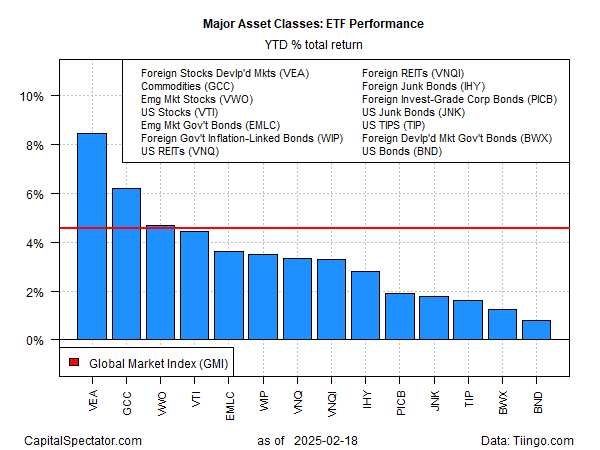After two straight years of performance dominance by US equities, foreign stocks in developed markets are leading the major asset classes by a wide margin so far in 2025, based on a set of ETFs through Tuesday’s close (February 18). It’s anyone’s guess if the leadership for equities ex-US continues, but at the moment the change in fortunes is a striking reshuffling of recent history.
Vanguard FTSE Developed Markets Index Fund ETF (NYSE:VEA) has surged 8.5% year to date, well ahead of the second-best performer, commodities (GCC), which is up 6.2%. In third place: emerging markets (VWO)) with a 4.7% increase. US stocks (VTI) are currently the fourth-best performer via a 4.4% advance.
For context, the Global Market Index (GMI) is up 4.6% so far this year. GMI is an unmanaged benchmark (maintained by CapitalSpectator.com) that holds all the major asset classes (except cash) in market-value weights via ETFs and represents a competitive benchmark for multi-asset-class portfolios.

The changing fortunes mark a switch following two consecutive calendar years of strong leadership for US equities. In 2024, for example, American shares rallied nearly 24%, far ahead of the rest of the field.
What’s driving the changing fortunes? Analyst Ed Yardeni this week suggests the Trump factor may be a reason:
“So far, Trump’s tariff turmoil seems to be weighing more on the US, Canada, Mexico, and many other emerging markets than on China and most European countries. That could change once reciprocal tariffs are actually imposed by the US in early April, unless Trump changes his mind, again.”
Whatever the catalyst, foreign developed markets are on a tear. VEA’s regional weighting tells the story. The Europe-developed category has the biggest weight in the fund: more than 40%, followed by Japan with a 21% share and the UK at 12%, according to Morningstar.com.
Meanwhile, the long-term expected return for US equities has fallen recently relative to the red-hot run over the past decade, {{art-based on modeling by CapitalSpectator.com}}. By contrast, ex-ante performance for foreign-developed stocks has been revised higher lately.
Despite the revisions, US and foreign-developed stocks are currently expected to generate similar results in the 8%-9% annualized total return range over the long haul. Using this year’s rally in foreign shares as a guide, however, suggests that the crowd is pricing in a wider divergence in the near term.
